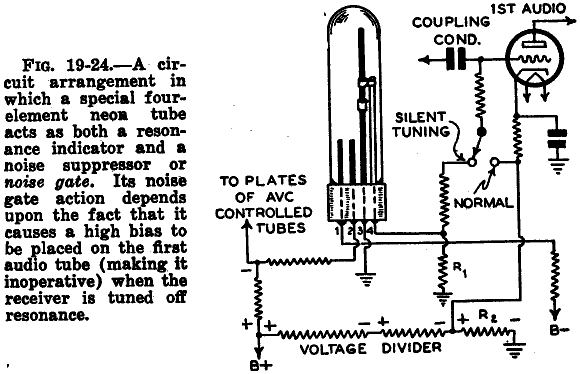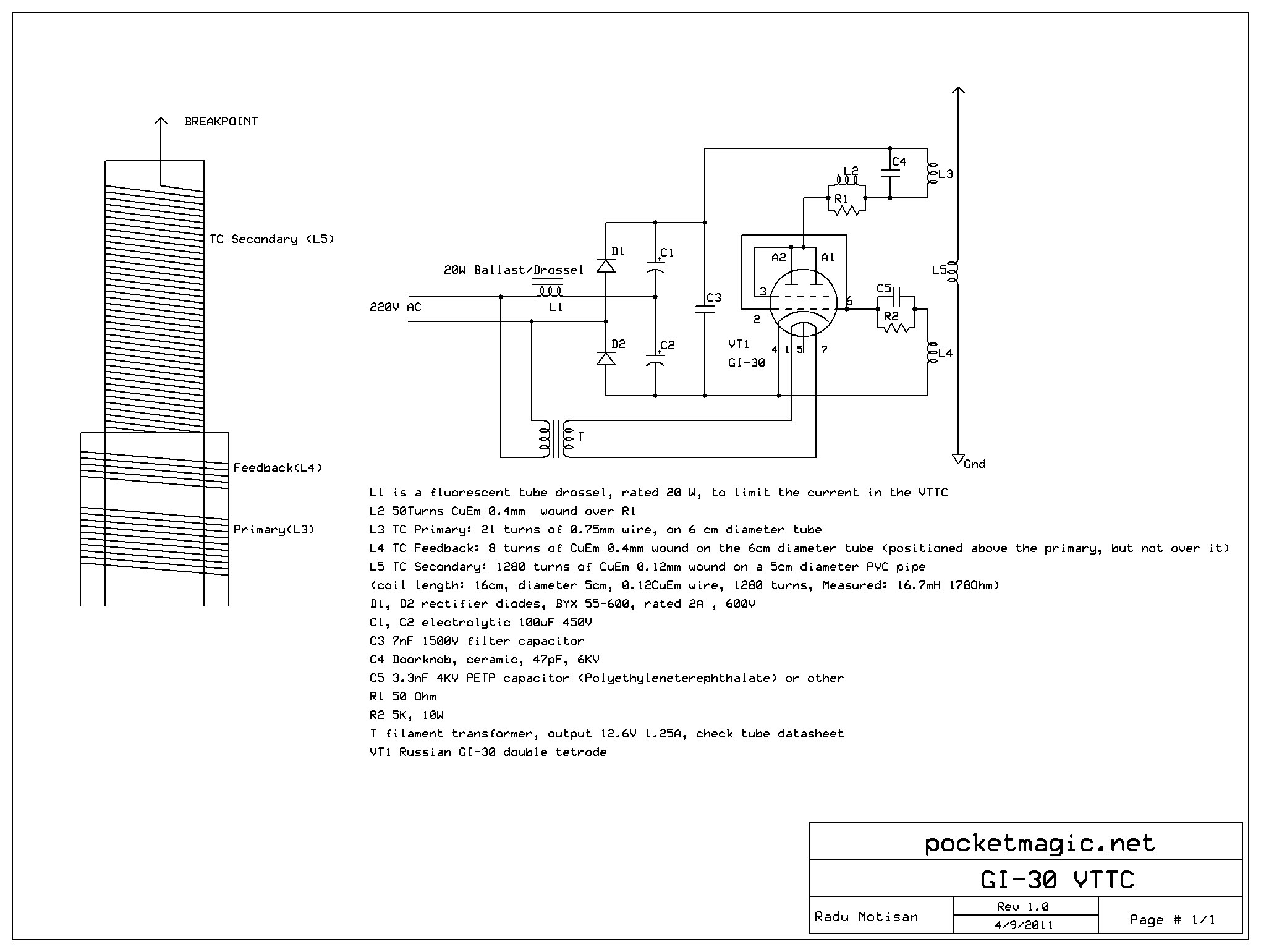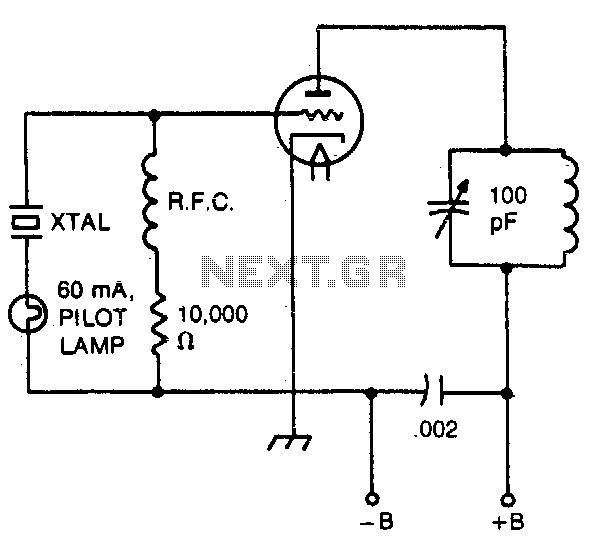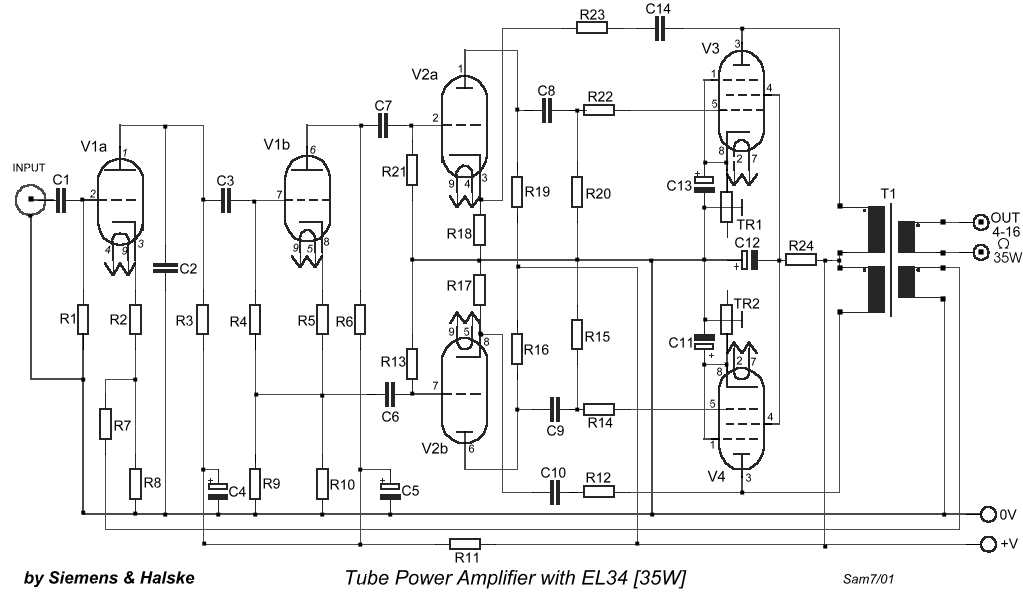
Tube Tune-A-Lite ID37856

The following two photos illustrate the I/V characteristics of the main anode/cathode current for the Tune-a-Lite 4-element neon tube, which serves as a signal strength meter in certain Fada radios, particularly in the Tune-o-Graph model. A similar 4-terminal Tuneon tube is utilized in some Cossor radios. The first photo depicts a low 130V trigger voltage for the main cathode, which is approximately equal to the operating voltage. This low trigger voltage is made possible by a 100µA current flowing through the small pilot cathode, located glowing to the lower right of the main cathode. The tube exhibits some darkening, a sign of usage. After approximately one hour of operation, the same 5mA maximum current was sufficient to illuminate the entire main cathode. The terminal numbering in the images follows the standard convention for 4-pin tubes, counted clockwise starting from the lower left thick pin when the two thick pins are positioned at the bottom. The presence of the small cathode mitigates the issue faced by 2-terminal Tune-a-Lite and similar tubes, which tend to activate suddenly only after a significant increase in voltage following the extinguishing of the glow. The pilot cathode is present in all 3-terminal and 4-terminal tubes of this design. As illustrated in the curve traces below, when the cathode glow is beneath the top of the T terminal, indicating less than 1mA of cathode current, the T terminal behaves as an open circuit. Once the glow reaches the top of the T, the terminal begins to conduct abruptly. If the load connected to the T is a common 500kΩ resistor to ground, the voltage at the T is approximately 15V when the glow is even with the top of the T, increasing to 40V at full glow with 5mA of cathode current. Some of the significant variation in voltage generated at the T terminal may result from cathode poisoning that develops in the cathode after prolonged inactivity. Cathode poisoning raises plasma potential. Over time, it was observed that the glow length increased, and the variation in positive bias with glow length became less pronounced. When the tube is operational, controlled by a user-operated enabling switch, the audio triode stage governed by the Tune-a-Lite is pre-biased below cutoff with a substantial positive voltage at the cathode, while the triode grid remains grounded. Therefore, between stations, the glow remains below the T, keeping the audio triode in the cutoff state. When the glow ascends to the top of the T, the positive voltage generated at the T biases the grid of the audio triode stage, allowing it to conduct and amplify, thereby eliminating muting. A strong station causes the glow to reach the top of the T. With 3-4mA flowing through the cathode, the T terminal begins to behave like a cathode when driven negatively; however, in this application, the 500kΩ load resistor to ground maintains conduction on the positive side of the curve, resembling a current source. Compared to similar tubes with only 2 or 3 terminals, this 4-terminal tube necessitates that the main cathode be grounded for the proper operation of the T terminal concerning the audio triode stage under muting control. Internal glow adjustment in the 4-terminal device is achieved using a potentiometer at the anode, while for 2 and 3-terminal tubes, adjustment can be made at either terminal. In summary, the operation of the T terminal provides a positive high-impedance current source into a 500kΩ load when strong stations elevate the glow past the top of the T. When the glow is below the T, no bias is generated, and the controlled audio stage remains off to prevent inter-station noise. For those seeking a replacement for this rare tube, a 3-wire IN-13 Russian analog bargraph tube or a 2-wire IN-9 version may serve as an alternative. An article link demonstrates how to integrate one of these analog bargraph tubes into a common AC/DC 5-tube radio.
The Tune-a-Lite 4-element neon tube operates under specific electrical characteristics that are crucial for its application as a signal strength indicator. The I/V characteristics observed in the photos highlight the relationship between the cathode current and the voltage across the T terminal. The design of the tube includes a pilot cathode that allows for a gradual increase in brightness, preventing sudden activation, which is a common drawback in simpler tube designs. The operational principle hinges on the cathode's glow reaching a threshold that enables the T terminal to conduct, facilitating the transition from a muted state to an amplified audio output.
In practical applications, the 500kΩ load resistor plays a vital role in stabilizing the operation of the T terminal, ensuring that it remains within the desired operating region. The adjustments made via the potentiometer at the anode are essential for fine-tuning the performance of the tube, allowing for compensation of variations due to factors such as cathode poisoning.
For circuit designers and engineers working with vintage audio equipment, understanding the nuances of this tube's operation is critical for maintaining or enhancing the performance of devices that utilize it. The potential for adapting modern components, such as the IN-13 or IN-9 tubes, offers alternative solutions for users facing challenges in sourcing original parts while preserving the functionality and aesthetic of classic radio designs.The following two photos show the I/V charactereristics of the main Anode/Cathode current for the Tune-a-lite 4 element neon tube used as signal strength meter in some Fada Radios as the Tune-o-graph. The 4 terminal Tuneon tube used in some Cossor radios works similarly to this tube. This first photo shows a low 130V trigger voltage for the main c athode that is approximately the same as the operating the voltage. This low trigger voltage is facilitated by the 100uA current flow through the small pilot cathode. The pilot cathode is seen glowing to the lower right of the main cathode. This tube has some darkening, indicating use. After about one hour of use, the same 5mA maximum current was enough to cover the entire main cathode with glow. The terminal numbering in the photos refers to the convention used with 4 pin tubes, with a clock-wise count starting at the lower left thick pin, when the two thick pins are at the bottom.
The small cathode eliminated the problem that the 2 terminal Tune-a-lite, and similar tubes, have of turning on suddenly, only when voltage is increased greatly after the glow is extinguished. The pilot cathode is present in all 3 terminal and 4 terminal tubes of this type. As the cruve traces below will show, when the cathode glow is below the top of the T, which is to say, with less than 1mA of cathode current, the T terminal behaves as an open circuit.
When the glow reaches the top of the T, the terminal starts conducting suddenly. If the load to the T is just the 500kOhms to ground that is common in the application circuit, the Voltage at the T is about 15V when the glow is even with the top of the T, and increases to 40V at full glow with 5mA of cathode current. Some of the large variation in generated voltage at the T terminal can be due to cathode poisoning that would develop in the cathode after decades of rest.
The cathode poisoning increases plasma potential. I noticed that the glow grew longer after some time, and the postitive bias variation with with glow lenght was less pronounced. When the tube is in use, with the enabling switch under user control, the audio triode stage under control of the Tune-a-Lite is pre-biased below cutoff with a large positive voltage at the cathode, and the triode grid is grounded.
So, between stations, the glow is below the T, and the audio triode remains cut off. When the glow reaches the top of the T, the positive voltage that is developed at the T, provides a bias to the grid of audio stage triode and brings it into conduction and amplification, thus stopping the muting. Astrong station causes the glow to reach the top of the T. With 3-4mA flowing through the cathode, the T terminal starts to fire like a cathode, if drive negative, but in the application, the 500K load resistor to ground keeps it`s conduction on the positive side of the curve, which behave more like a current source.
As compared to similar tubes with only 3 or 2 terminals, this 4 terminal tube requires that the main cathode be grounded for proper operation of the T terminal with respect to the audio triode stage under muting control. The internal glow adjustment in the 4 terminal device is done with a potentiometer at the Anode, while it may be done on either terminal of the 3 and 2 terminal tubes.
Summarizing the operation of the T terminal, it provides a positive high impedance current source into a 500K load when strong stations bring the glow past the top of the T. When the glow is below the T, no bias is developed, and the controlled audio stage remains off to prevent inter-station noise.
If you need a replacement for this very rare tube, you may be able to improvise with a 3 wire IN-13 Russian analog bargraph Tube, or a 2 wire IN-9 version. This article link shows how to add one of these analog bargraph tubes to a common AC/DC 5 tube radio.
🔗 External reference
The Tune-a-Lite 4-element neon tube operates under specific electrical characteristics that are crucial for its application as a signal strength indicator. The I/V characteristics observed in the photos highlight the relationship between the cathode current and the voltage across the T terminal. The design of the tube includes a pilot cathode that allows for a gradual increase in brightness, preventing sudden activation, which is a common drawback in simpler tube designs. The operational principle hinges on the cathode's glow reaching a threshold that enables the T terminal to conduct, facilitating the transition from a muted state to an amplified audio output.
In practical applications, the 500kΩ load resistor plays a vital role in stabilizing the operation of the T terminal, ensuring that it remains within the desired operating region. The adjustments made via the potentiometer at the anode are essential for fine-tuning the performance of the tube, allowing for compensation of variations due to factors such as cathode poisoning.
For circuit designers and engineers working with vintage audio equipment, understanding the nuances of this tube's operation is critical for maintaining or enhancing the performance of devices that utilize it. The potential for adapting modern components, such as the IN-13 or IN-9 tubes, offers alternative solutions for users facing challenges in sourcing original parts while preserving the functionality and aesthetic of classic radio designs.The following two photos show the I/V charactereristics of the main Anode/Cathode current for the Tune-a-lite 4 element neon tube used as signal strength meter in some Fada Radios as the Tune-o-graph. The 4 terminal Tuneon tube used in some Cossor radios works similarly to this tube. This first photo shows a low 130V trigger voltage for the main c athode that is approximately the same as the operating the voltage. This low trigger voltage is facilitated by the 100uA current flow through the small pilot cathode. The pilot cathode is seen glowing to the lower right of the main cathode. This tube has some darkening, indicating use. After about one hour of use, the same 5mA maximum current was enough to cover the entire main cathode with glow. The terminal numbering in the photos refers to the convention used with 4 pin tubes, with a clock-wise count starting at the lower left thick pin, when the two thick pins are at the bottom.
The small cathode eliminated the problem that the 2 terminal Tune-a-lite, and similar tubes, have of turning on suddenly, only when voltage is increased greatly after the glow is extinguished. The pilot cathode is present in all 3 terminal and 4 terminal tubes of this type. As the cruve traces below will show, when the cathode glow is below the top of the T, which is to say, with less than 1mA of cathode current, the T terminal behaves as an open circuit.
When the glow reaches the top of the T, the terminal starts conducting suddenly. If the load to the T is just the 500kOhms to ground that is common in the application circuit, the Voltage at the T is about 15V when the glow is even with the top of the T, and increases to 40V at full glow with 5mA of cathode current. Some of the large variation in generated voltage at the T terminal can be due to cathode poisoning that would develop in the cathode after decades of rest.
The cathode poisoning increases plasma potential. I noticed that the glow grew longer after some time, and the postitive bias variation with with glow lenght was less pronounced. When the tube is in use, with the enabling switch under user control, the audio triode stage under control of the Tune-a-Lite is pre-biased below cutoff with a large positive voltage at the cathode, and the triode grid is grounded.
So, between stations, the glow is below the T, and the audio triode remains cut off. When the glow reaches the top of the T, the positive voltage that is developed at the T, provides a bias to the grid of audio stage triode and brings it into conduction and amplification, thus stopping the muting. Astrong station causes the glow to reach the top of the T. With 3-4mA flowing through the cathode, the T terminal starts to fire like a cathode, if drive negative, but in the application, the 500K load resistor to ground keeps it`s conduction on the positive side of the curve, which behave more like a current source.
As compared to similar tubes with only 3 or 2 terminals, this 4 terminal tube requires that the main cathode be grounded for proper operation of the T terminal with respect to the audio triode stage under muting control. The internal glow adjustment in the 4 terminal device is done with a potentiometer at the Anode, while it may be done on either terminal of the 3 and 2 terminal tubes.
Summarizing the operation of the T terminal, it provides a positive high impedance current source into a 500K load when strong stations bring the glow past the top of the T. When the glow is below the T, no bias is developed, and the controlled audio stage remains off to prevent inter-station noise.
If you need a replacement for this very rare tube, you may be able to improvise with a 3 wire IN-13 Russian analog bargraph Tube, or a 2 wire IN-9 version. This article link shows how to add one of these analog bargraph tubes to a common AC/DC 5 tube radio.
🔗 External reference
Warning: include(partials/cookie-banner.php): Failed to open stream: Permission denied in /var/www/html/nextgr/view-circuit.php on line 713
Warning: include(): Failed opening 'partials/cookie-banner.php' for inclusion (include_path='.:/usr/share/php') in /var/www/html/nextgr/view-circuit.php on line 713





